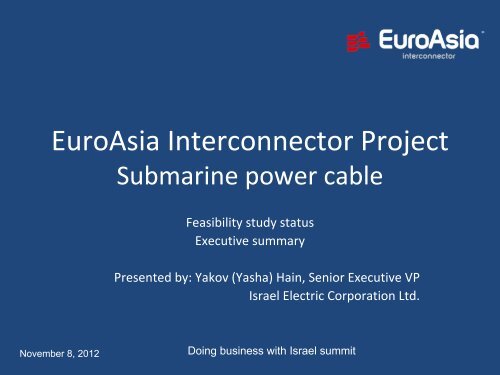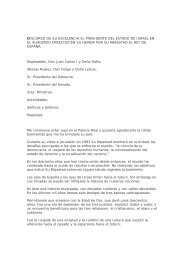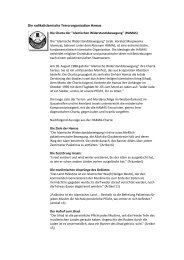EuroAsia Interconnector Project Submarine power cable
EuroAsia Interconnector Project Submarine power cable
EuroAsia Interconnector Project Submarine power cable
You also want an ePaper? Increase the reach of your titles
YUMPU automatically turns print PDFs into web optimized ePapers that Google loves.
<strong>EuroAsia</strong> <strong>Interconnector</strong> <strong>Project</strong><br />
<strong>Submarine</strong> <strong>power</strong> <strong>cable</strong><br />
Feasibility study status<br />
Executive summary<br />
Presented by: Yakov (Yasha) Hain, Senior Executive VP<br />
Israel Electric Corporation Ltd.<br />
November 8, 2012<br />
Doing business with Israel summit
<strong>EuroAsia</strong> <strong>Interconnector</strong> <strong>Project</strong><br />
<strong>Submarine</strong> <strong>power</strong> <strong>cable</strong><br />
Feasibility study status<br />
Executive summary<br />
Presented by: Yakov (Yasha) Hain, Senior Executive VP<br />
Israel Electric Corporation Ltd.<br />
November 8, 2012<br />
Doing business with Israel summit
<strong>Project</strong> description<br />
• Euro‐Asia <strong>Interconnector</strong> is a project intended to link<br />
the electrical systems of Israel, Cyprus and Greece<br />
(via Crete) through sub‐marine DC <strong>cable</strong>s and HVDC<br />
onshore stations in each country<br />
• Total capacity – 2000 MW<br />
• Participants:<br />
– DEH‐Quantum Energy<br />
– Electricity Authority of Cyprus<br />
– TSO ‐ Cyprus<br />
– Israel Electric Corporation<br />
November 8, 2012<br />
Doing business with Israel summit 3
<strong>Project</strong> activities ‐ MOU<br />
March 04, 2012. Tel Aviv. Israel<br />
endorsed its commitment to<br />
implementing the <strong>EuroAsia</strong><br />
<strong>Interconnector</strong> energy bridge<br />
project connecting Greece, Cyprus<br />
and Israel signing an agreement<br />
with DEH‐Quantum Energy LLC.<br />
March 23, 2012. Nicosia. The<br />
Electricity Authority of Cyprus<br />
formalized its participation in the<br />
three‐nation operation to lay the<br />
<strong>EuroAsia</strong> <strong>Interconnector</strong> submarine<br />
electricity <strong>cable</strong> signing a<br />
cooperation agreement with PPC ‐<br />
Quantum Energy LLC<br />
November 8, 2012<br />
Doing business with Israel summit 4
<strong>Project</strong> activities –working<br />
groups<br />
April 23, 2012. Nicosia. The first<br />
Steering Committee Meeting.<br />
The Committee took decision on<br />
Feasibility study and schedule<br />
for its implementation<br />
June 13, 2012. Tel Aviv. Finalization of the Steering<br />
Committee and the Working Groups. Chairman of ΔΕΗ‐<br />
Quantum Mr. Athanasios Ktorides informed the Steering<br />
Committee that the Cyprus Government had applied to EU<br />
for consideration and approval of the <strong>EuroAsia</strong><br />
<strong>Interconnector</strong> as a cross‐border project of common interest.<br />
November 8, 2012<br />
Doing business with Israel summit 5
<strong>Project</strong> activities –working<br />
groups<br />
Network analysis<br />
Group coordinator: Dr. David Elmakias, IEC<br />
Group coordinator: Mr. Stavros Stavrinos, TSO Cyprus<br />
Dr. Elias Kyriakides, ΔΕΗ-QUANTUM<br />
Mr. Pavel Kulbekov, IEC<br />
Dr. Yair Malakhi, IEC<br />
Mrs. Sanda Harel, IEC<br />
Mr. Evaggelos Anastasiades, EAC<br />
Mr. Ioannis Papageorgiou, EAC<br />
Market analysis and regulation<br />
Group coordinator: Ms. Dimitra Croba,<br />
ΔΕΗ-QUANTUM<br />
Dr. Vladimir Podshivalov, IEC<br />
Ms. Tali Shitrit, IEC<br />
Mr. Sylvian Locar, IEC<br />
Mr. Andreas Poullikas, EAC<br />
Mr. Constantinos Rouvas, EAC<br />
Cable routing and environmental<br />
Group coordinator: Mr. Athanasios<br />
Stivaros, ΔΕΗ-QUANTUM<br />
Dr. Hanoch Ben-Haim, IEC<br />
Dr. Tal Katz, IEC<br />
Mr. Tasos Gregoriou, EAC<br />
Technology issues: <strong>cable</strong> and converter station<br />
Group coordinator: Dr. Hanoch Ben-Haim, IEC<br />
Dr. Elias Kyriakides, ΔΕΗ-QUANTUM<br />
Mr. Ilan Akons, IEC<br />
Mr. Ziv Nir, IEC<br />
Mr. Dinos Charalambides, EAC<br />
Generation<br />
Mrs. Sanda Harel, IEC<br />
Mr. Pavel Kulbekov, IEC<br />
Dr. Yair Malakhi, IEC<br />
Mr. Andreas Poullikas, EAC<br />
Mr. Constantinos Rouvas, EAC<br />
November 8, 2012<br />
Doing business with Israel summit 6
Description of electricity<br />
systems<br />
Greece<br />
Capacity –12,890 MW<br />
Production –51.9 TWh*<br />
Cyprus<br />
Capacity –1,400 MW<br />
Production –5.2 TWh<br />
* incl. export/import<br />
November 8, 2012<br />
Israel<br />
Capacity –13,131 MW<br />
Production –57.3 TWh<br />
Doing business with Israel summit 7
Preliminary <strong>cable</strong> route<br />
Greece<br />
Crete<br />
Cyprus<br />
Israel<br />
The route consists of three sectors:<br />
• Israel –Cyprus section between Hadera site in Israel and Vasilikos site in<br />
Cyprus.<br />
• Cyprus –Crete section between Vasilikos site in Cyprus and Korakia site<br />
in Crete.<br />
• Crete –Continental Greece section between Korakia site in Crete and<br />
Attica region in Continental Greece.<br />
November 8, 2012<br />
Doing business with Israel summit 8
Preliminary <strong>cable</strong><br />
route<br />
Section<br />
Israel –Cyprus<br />
Length, km<br />
330<br />
Maximal<br />
depth, m<br />
2300<br />
Cyprus –Crete<br />
Crete – Continental<br />
Greece<br />
880<br />
310<br />
2700<br />
1400<br />
November 8, 2012<br />
Doing business with Israel summit 9
Preliminary <strong>cable</strong><br />
route<br />
The major challenge of this project – sea depth<br />
November 8, 2012<br />
Doing business with Israel summit 10
Technology issues<br />
Request for Information has been prepared<br />
and distributed to the main manufacturers of<br />
HVDC equipment<br />
Four manufacturers answered the RFI:<br />
• Alstom as a HVDC converter manufacturer<br />
• ABB as a HVDC converter and submarine <strong>cable</strong>s<br />
manufacturer<br />
• Siemens as a HVDC converter manufacturer<br />
• Prysmian as a sub‐marine <strong>cable</strong>s manufacturer<br />
Siemens and Prysmian participated in RFI as a<br />
consortium.<br />
November 8, 2012<br />
Doing business with Israel summit 11
Technology issues ‐ <strong>cable</strong><br />
Mass‐Impregnated (MI) Cable<br />
The technology is available for<br />
voltages up to 600 kV and a<br />
transmission capacity of up to<br />
2200 MW<br />
XPLE Cable<br />
The technology is available<br />
for voltages up to 320 kV and a<br />
transmission capacity of up to<br />
1000 MW in one <strong>cable</strong><br />
Preliminary conclusion:<br />
•The project is technologically feasible based on MI 500kV 500 MW<br />
<strong>cable</strong>s.<br />
• <strong>Project</strong> schedule is determined by the submarine <strong>cable</strong> availability<br />
including R&D stage and manufacturing/installation duration<br />
November 8, 2012<br />
Doing business with Israel summit 12
Technology issues ‐ converter<br />
Line commutated LCC<br />
LCC is the most widely<br />
adopted technology with<br />
many years of service<br />
experience but has<br />
limitation for bidirectional<br />
energy flow.<br />
Preliminary conclusion: feasible<br />
Self‐commutated VSC<br />
VSC technology allows bi-directional<br />
energy flow and true multi-terminal<br />
control.<br />
VSC converters have already<br />
implemented in a few projects, and<br />
planned for on-going projects at +/-<br />
300kV and 350kV.<br />
Theoretically there is no limitation to<br />
voltage level and +/- 500kV VSC<br />
converter is feasible.<br />
November 8, 2012<br />
Doing business with Israel summit 13
Technology issues ‐<br />
configuration<br />
There are three main HVDC basic systems:<br />
• Monopolar HVDC systems<br />
• Bipolar HVDC systems<br />
• Multi‐terminal HVDC systems<br />
Preliminary conclusion:<br />
At this level of information the best alternative is a bipolar configuration<br />
with monopolar bypass and sea electrodes.<br />
The final choice of the configuration will be optimized according to<br />
energy flow and reliability needs.<br />
November 8, 2012<br />
Doing business with Israel summit 14
Network analysis. Study<br />
Objectives<br />
• DC link impact study on existing transmission system.<br />
• HVDC connection to the transmission system<br />
• Steady State analysis of existing system with DC<br />
<strong>cable</strong> connection from the thermal limits and voltage<br />
constraints perspective<br />
• Transmission expansion plan to make possible the<br />
connection of up to 1000 and 2000MW<br />
• Power flow calculation of DC link –<strong>power</strong> losses and<br />
voltage changes<br />
• Contingency Analysis<br />
November 8, 2012<br />
Doing business with Israel summit 15
Network analysis. Israel<br />
Dynamic Analysis<br />
• In order to maintain stability after a fault, imported <strong>power</strong><br />
should not exceed 30% of the local load.<br />
• An HVDC Interconnection with a 1000 MW capacity is not<br />
expected to present a problem at any point in time.<br />
• An outage of the HVDC Interconnection with a capacity of<br />
2000 MW during export could:<br />
– Risk the integrity of the Israeli <strong>power</strong> system during 3.7% of the time<br />
in the year 2022.<br />
– Cause severe disruptions in energy supply during 5.5% of the time in<br />
the year 2022.<br />
– The risk posed by an outage of a 2000 MW HVDC Interconnection<br />
could be reduced by lowering the capacity factor or by redesign of<br />
system protections.<br />
November 8, 2012<br />
Doing business with Israel summit 16
Network analysis. Cyprus<br />
• Importing <strong>power</strong> into the Cyprus system, maximum <strong>power</strong><br />
loss of 225 MW may be tolerated. It will result in<br />
disconnection of 11% of the consumer loads for at least 15‐<br />
20 minutes. The disconnected consumers will be restored<br />
within 15‐20 minutes by starting the five peaking open‐cycle<br />
gas turbine units, provided that they are available.<br />
• For a sudden loss of <strong>power</strong> import higher than 225 MW, the<br />
resulting shed consumer loads will require a substantially<br />
higher restoration time, ranging from 4 to 6 hours,<br />
depending on the system conditions, as large steam<br />
generating units will have to be committed.<br />
November 8, 2012<br />
Doing business with Israel summit 17
Network analysis. Cyprus<br />
• The maximum <strong>power</strong> that can be imported is<br />
between 850‐900 MW, but if one of the two DC<br />
<strong>cable</strong>s is tripped during such an operation, at least<br />
27% of the system load will be shed and the<br />
corresponding restoration time will be of the order<br />
of several hours, which is unacceptable.<br />
• Higher import is not feasible, due to the constraint<br />
imposed by the minimum stable loading levels of<br />
the generating units.<br />
November 8, 2012<br />
Doing business with Israel summit 18
Market analysis. Greece<br />
• Greece is an “electrical<br />
peninsula”. Greek Wholesale<br />
Market has a weak correlation<br />
with the major European markets<br />
and exhibits higher level of<br />
wholesale prices<br />
• All the northern neighbors of<br />
Greece have lower prices and are<br />
net importers to the Greek<br />
market<br />
• Italy –another “electrical<br />
peninsula” is the only stable net<br />
importer from Greece.<br />
November 8, 2012<br />
Note: we do not examine here the feasibility<br />
of Crete-Greece interconnection , which is<br />
clearly proved already<br />
Doing business with Israel summit 19
Market analysis. Greece<br />
• Electricity production costs in Israel in the medium<br />
perspective are going to be lower than the Greek ones<br />
• This situation dictates the Greek market as a primary target<br />
for <strong>EuroAsia</strong> <strong>Interconnector</strong> project<br />
• The Italian market is considered as a secondary target,<br />
(+) characterized by high level of prices and<br />
(+) much larger trading activity, but<br />
(‐) access to the market is limited due to the lack of<br />
transmission capacity<br />
Dominant <strong>power</strong> flow through <strong>EuroAsia</strong> <strong>Interconnector</strong><br />
South (Cyprus, Israel) to North (Greece)<br />
November 8, 2012<br />
Doing business with Israel summit 20
Market analysis<br />
Main scenarios<br />
• Development plans of Cyprus, Greece and Israel based<br />
mainly on gas fired CCGT units and use of renewable<br />
energy sources<br />
• We are expecting a stable gap of 7‐8 $/MMBTU<br />
between Greek and Israeli NG prices in favor of Israel.<br />
• It’s equivalent to 35‐40 €/MWh difference in marginal<br />
costs (operational variable costs) for modern units<br />
• The price of Cypriot natural gas is less certain.<br />
• We consider three scenarios which are dictated by<br />
three Cypriot gas prices possibilities<br />
November 8, 2012<br />
Doing business with Israel summit 21
Market analysis. Scenario A<br />
“No‐change”<br />
• Fuel prices in Cyprus are similar to the<br />
current level<br />
• The marginal costs are the highest in Cyprus<br />
• Cypriot export to other countries in such<br />
conditions is uneconomical, so Cyprus is<br />
going to be electricity net importer from the<br />
<strong>cable</strong>.<br />
• Both Greek and Israeli electricity is competitive for Cypriot market, but Israeli<br />
electricity, due to their lower costs, has a priority<br />
• Greek export to Cyprus is hardly possible as a stable business pattern<br />
• Relatively small Cypriot market can't fully use the Cable capacity<br />
• The remaining part of electricity is sold at the Greek market<br />
November 8, 2012<br />
Doing business with Israel summit 22
Market analysis. Scenario B<br />
“Gas parity scenario”<br />
• Fuel prices in Cyprus are similar to<br />
those in Israel.<br />
• The marginal costs (operational<br />
variable costs) is highest in Greece.<br />
Greek export to other countries in<br />
such conditions is uneconomical,<br />
• Greece is energy net importer from<br />
the <strong>cable</strong>.<br />
• Both Cypriot and Israeli electricity is competitive for Greek<br />
market, nobody has a priority.<br />
• Israeli export to Cyprus or Cypriot to Israel is hardly possible as a<br />
stable business pattern.<br />
November 8, 2012<br />
Doing business with Israel summit 23
Market analysis. Scenario C<br />
“Cypriot energy hub scenario”<br />
• Fuel prices in Cyprus are much lower<br />
than in Israel.<br />
• The marginal costs (operational<br />
variable costs) will be lowest in Cyprus<br />
• Cypriot export to both other countries<br />
–Greece and Israel ‐ is economical, so<br />
Cyprus will be energy net exporter to<br />
the <strong>cable</strong>.<br />
• Both Greek and Israeli electricity are going to consume Cypriot<br />
electricity<br />
• This scenario dictates a need for construction of CCGT plants in<br />
Cyprus which will produce electricity mainly for export.<br />
November 8, 2012<br />
Doing business with Israel summit 24
Summary<br />
• Finalising of Feasibility Study report –<br />
02/2013<br />
• <strong>Project</strong> implementation:<br />
– 2018, first stage Israel‐Cyprus and Greece‐<br />
Crete;<br />
– 2020, second stage Cyprus‐Crete.<br />
November 8, 2012<br />
Doing business with Israel summit 25
Thank you<br />
November 8, 2012<br />
Doing business with Israel summit
















